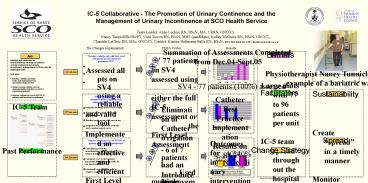IC5 Collaborative The Promotion of Urinary Continence and the Management of Urinary Incontinence at - PowerPoint PPT Presentation
1 / 1
Title:
IC5 Collaborative The Promotion of Urinary Continence and the Management of Urinary Incontinence at
Description:
- 77 patients on SV4 assessed using. either the full IC-5 ... Nancy Tunnicliffe BScPT, Vicki Rozon RN, BScN, MHS (candidate), Kelley McGuire RN, BScN, GNC(C) ... – PowerPoint PPT presentation
Number of Views:237
Avg rating:3.0/5.0
Title: IC5 Collaborative The Promotion of Urinary Continence and the Management of Urinary Incontinence at
1
IC-5 Collaborative - The Promotion of Urinary
Continence and the Management of Urinary
Incontinence at SCO Health Service
Team Leader Anne Leclerc RN, BScN, MA, CRRN,
GNC(C) Nancy Tunnicliffe BScPT, Vicki Rozon RN,
BScN, MHS (candidate), Kelley McGuire RN, BScN,
GNC(C), Chantale LeClerc RN, MSc, GNC(C),
Contact Kirsten Heilmann-Stille RN, BScN, (613)
562-4262 ext. 1337, kheilman_at_scohs.on.ca
The Changes Implemented
PDSA Cycles
Results
Lessons Learned
- Large units with 77 to 96 patients per unit
- IC-5 team spread throughout the hospital
- Dissemination of information to all team
- members on all shifts
- Paucity of information and equipment for
- Bariatric population
- Previous attempts to implement a urinary
- continence program failed
- Develop and implement an
- interdisciplinary strategy to optimize
- urinary continence and urinary
- incontinence management on three units by
- September 2005.
- Sub-aims
- 1. Develop a reliable and valid
- First Level Assessment Tool
- and assess all pts on SV4
- 2. Reduce urinary catheter use and
- eliminate bladder irrigation on all SV3
- catheterized patients
Barriers
- Develop a reliable and valid First Level
- Assessment Tool and assess all
- patients on SV4
- Assessed all pts on SV4 using a reliable
- and valid tool
- Implemented an effective and efficient
- First Level Assessment tool for all new
- CCC Admissions
- Identified patients with potential to
- benefit from further evaluation to undergo
- the Second Level Urinary Assessment
Aim
- 77 patients on SV4 assessed
using either the full IC-5
assessment or the First
Level Assessment - Used multiple
PDSA cycles to validate First Level
Assessment questions and format
- MDS data, clinical observation and the IC-5
Assessment Tool used to formulate first draft
and test First Level Assessment
Summation of Assessments Completed from
Dec.04-Sept.05
photo or image
1st Sub-aim
Physiotherapist Nancy Tunnicliffe with an
example of a bariatric walker
SV4 - 77 patients (100) assessed
- Create spread in a timely manner
- Monitor outcomes and resources using existing
- Databases (e.g., MDS, Supply Service Inventory)
- Change support structures
- (e.g. documentation, forms, inventory)
- Link Continence Care to other quality
- improvement priorities and Best Practice
- programs (e.g., wound care)
- Maintain link with other IC-5 Collaborative
- participants
Facilitators
Sustainability
- Reduce catheter use and
- eliminate bladder irrigation on all
- catheterized patients on SV3
- Irrigation no longer part of care routine
- Protocol in place with supporting
- documentation
- Smallest catheter and bulb now in use
- Irrigation trays eliminated from the
- units medical supply carts
- Elimination of Catheter
irrigation - Introduced
products Hydrogel catheter and Statlock
securement device - Multiple
PDSA cycles involving more
patients and nurses and
refining of catheter care protocol -
Identified 1 patient with high chance of
success and eliminated irrigation -
Introduced information regarding catheter
care best practices to identified early adopters
Catheter Best Practice Implementation Results on
SV3
IC-5 Team
2nd Sub-aim
- Improve continence care on SV2 for 10
- patients with functional incontinence
- Established process for
- interdisciplinary care planning (ICP) to
- address functional incontinence issues
- Continence care in the bariatric
- population identified as a priority by
- the interdisciplinary team
- Purchased bariatric equipment to
- support continence
- - 6 of 7 patients
had an - improvement in
continence - - 7 of 10 patients had
interventions implemented through - - Nine more patients with
functional - incontinence (including a
bariatric - patient) identified through
assessment - - Identified 1 patient with functional
- incontinence and implemented an ICP
- - Interdisciplinary education for continence
- promotion related to functional incontinence
- provided
Spread
Outcomes for interdisciplinary interventions for
10 patients with functional incontinence
Change Strategy
Past Performance
40
40
3rd Sub-aim
20
Four patients experienced a reduction in daytime
incontinence and two patients achieved continence
Registered Nurses Association of Ontario































